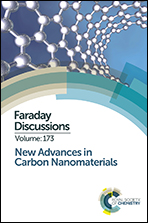Few layer graphene–polypropylene nanocomposites: the role of flake diameter
Abstract
Graphene shows excellent potential as a structural reinforcement in polymer nanocomposites due to its exceptional mechanical properties. We have shown previously that graphene composites can be analysed using conventional composite theory with the graphene flakes acting as short fillers which have a critical length of ∼3 μm which is required for good reinforcement. Herein, polypropylene (PP) nanocomposites were prepared using electrochemically-exfoliated few layer graphene (FLG) with two different flake diameters (5 μm and 20 μm). The crystallization temperature and degree of crystallinity of the PP were found to increase with the loading of FLG, which suggests that the flakes acted as crystallisation nucleation sites. Mechanical testing showed that the 5 μm flakes behaved as short fillers and reinforced the PP matrix poorly. The modulus of the 20 μm flake composites, however, increased linearly with loading up to 20 wt%, without any of the detrimental aggregation effects seen in other graphene systems. The mechanical data were compared with our previous work on other graphene composite systems and the apparent need to balance the degree of functionalization to improve matrix compatibility whilst not encouraging aggregation is discussed.
- This article is part of the themed collection: New Advances in Carbon Nanomaterials

 Please wait while we load your content...
Please wait while we load your content...